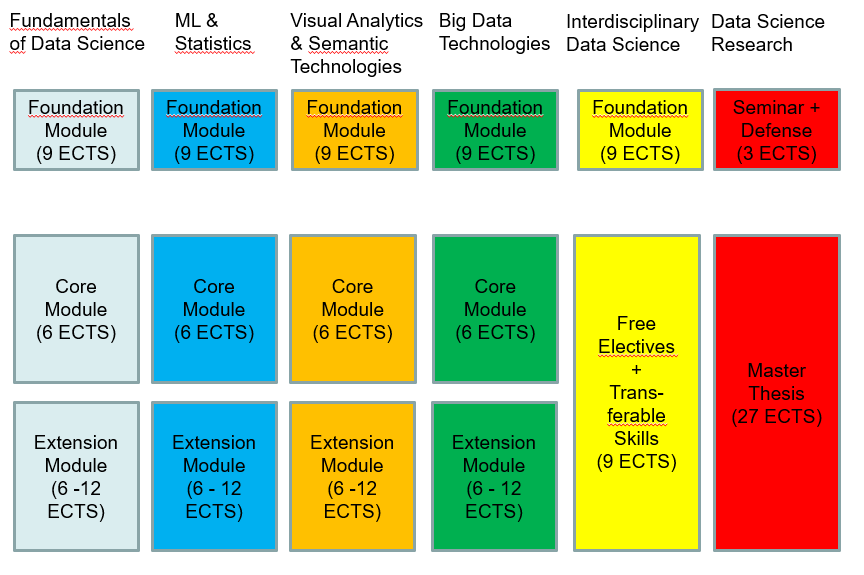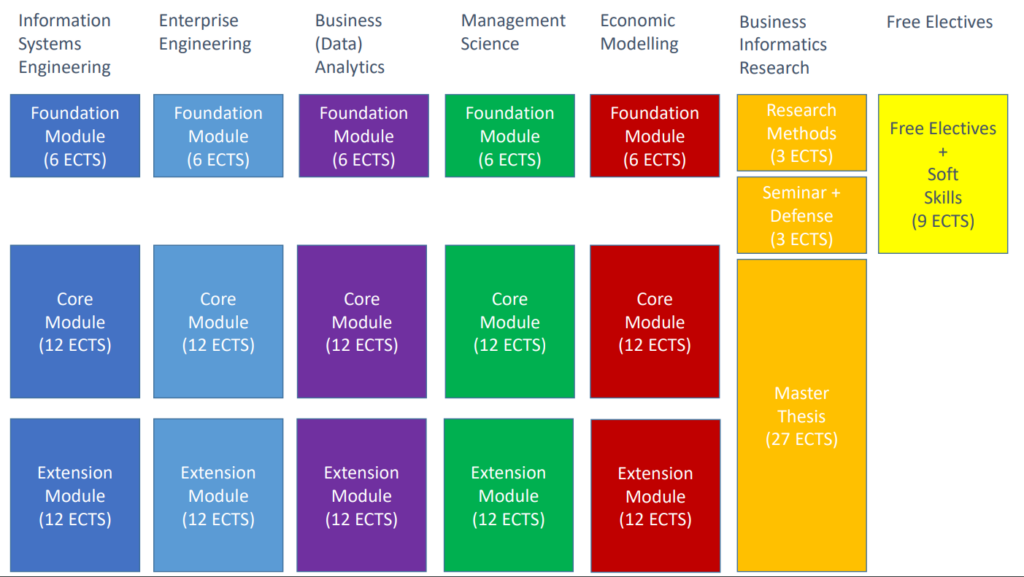The basis of your studies is the study plan, also called curriculum. Each course (LVA) brings a certain number of ECTS points, which reflect the workload (1 ECTS = approx. 25 hours of work).
The Master’s programs Data Science & Business Informatics comprise 120 ECTS, which corresponds to a study duration of four semesters full-time. Note that the course is held in English.
In contrast to the Bachelor’s program, there is no STEOP (study entrance and orientation phase) in the Master’s program. So you are free to choose from the courses in your study plan right from the start, as long as you meet the respective requirements.
Master Data Science
The Master’s program is divided into different module groups. Here is an overview of how your 120 ECTS are composed:
1. Mandatory Modules
There are four “Foundation” modules that will give you the basic knowledge in the core areas of Data Science. Each of these modules consists of courses that must both be completed positively. These include:
- Module FDS/FD – Fundamentals of Data Science – Foundations
- VU AKSTA Statistical Computing (3.0 ECTS)
- VU Experiment Design and Execution (6.0 ECTS)
- Module MLS/FD – Machine Learning and Statistics – Foundations
- VU Advanced Methods for Regression and Classification (4.5 ECTS)
- VU Machine Learning (4.5 ECTS)
- Module BDHPC/FD – Big Data and High Performance Computing – Foundations
- VU Advanced Database Systems (6.0 ECTS)
- VU Data-intensive Computing (3.0 ECTS)
- Module VAST/FD – Visual Analytics and Semantic Technologies – Foundations
- VU Information Visualization (3.0 ECTS)
- VU Introduction to Semantic Systems (3.0 ECTS)
Another compulsory module is Module DSA – Domain-Specific Aspects of Data Science, consisting of:
- VU Interdisciplinary Lecture Series on Data Science (1.0 ECTS)
- PR Interdisciplinary Project in Data Science (5.0 ECTS)
- VU Domain-Specific Lectures in Data Science (3.0 ECTS)
Note
It’s generally up to you in what order you complete the courses. However, it makes sense to complete the Foundations (and any prerequisites) first.
The recommended semester breakdown of courses can be found in TISS in the Semester View tab.
2. Key Areas
For each of the Foundation modules above, there are also associated “key areas”. Each key area consists of:
- Core module (6 ECTS): A compulsory module that you must complete if you choose this key area
- Extension module (max. 18 ECTS): Here you can choose from a catalog of elective courses to deepen your knowledge.
You must choose at least two key areas and complete the core module. From the key areas you have chosen, you can then complete the extension modules (max. 18 ECTS each) in order to reach a total of 120 ECTS in your studies.
Tip
It is irrelevant in which order you attend courses (except for any registration requirements for individual courses). In principle, you can also attend extension modules before core and foundations modules — even if this is of course not particularly recommended.
Likewise, the “choice” of key areas is not really a choice – the only relevant thing is that you meet the curriculum conditions when you submit your master’s degree. This means that you can change your key areas at any time.
3. Elective Courses and Transferable Skills (9 ECTS)
In this area you have freedom:
- Transferable Skills: You must complete courses to the extent of at least 4.5 ECTS from the Transferable Skills Catalog.
- Free electives: You can fill the remaining ECTS of this subject with any courses from the TU Wien or other universities.
4. Master’s Thesis (30 ECTS)
The master’s thesis is a central part of your studies and is accompanied by a Seminar for Diploma Students for Data Science.

Master Business Informatics
The Master’s program in Business Informatics is divided into different module groups. Here is an overview of how your 120 ECTS are composed:
1. Business Informatics Foundations (39 ECTS)
There are four “Foundation” modules that will give you the basic knowledge in the core areas of Business Informatics. Each of these modules consists of one or more courses, all of which must be completed positively. These include:
- Module DA/FD – Data Analytics Foundation
- VU Business Intelligence (6.0 ECTS)
- Module EE/FD – Enterprise Engineering Foundation
- VU Enterprise & Process Engineering (6.0 ECTS)
- Module EM/FD – Economic Modeling Foundation
- VU Computational Social Simulation (3.0 ECTS)
- VU Econometrics for Business Informatics (3.0 ECTS)
- Module ISE/FD – Information Systems Engineering Foundation
- VU Model Engineering (6.0 ECTS)
- Module MS/FD – Management Science Foundation
- VO Human Resource Management and Leadership (3.0 ECTS)
- VU IT-based Management (3.0 ECTS)
- Module RM/FD – Research Methods
- SE Research Methods (3.0 ECTS)
Another compulsory module is Module RM/FD – Research Methods, consisting of SE Research Methods (3.0 ECTS)
Note
It’s generally up to you in what order you complete the courses. However, it makes sense to complete the Foundations (and any prerequisites) first.
2. Key Areas (48 ECTS)
For each of the Foundation modules above, there are also associated “key areas”. Each key area that belongs to a Foundation module consists of a Core module (12 ECTS) and an Extension module (12 ECTS).
You must complete a total of 48 ECTS from these modules. The following applies:
- An Extension module can only be selected if the associated Core module is also completed.
This means you have various combination options to reach your 48 ECTS. For example:
- You choose four different core modules. (4 x 12 ECTS = 48 ECTS)
- You choose two core modules and the two associated extension modules to specialize strongly. (2 x 12 ECTS + 2 x 12 ECTS = 48 ECTS)
- You choose three core modules and one associated extension module. (3 x 12 ECTS + 1 x 12 ECTS = 48 ECTS)
Note
Depending on which focus you had in your Bachelor’s program, there are special requirements for the choice of your key areas in the Master’s in Business Informatics:
If you have a Bachelor’s degree with a focus on computer science (and less than 24 ECTS in economics), you must complete at least two modules from MS/COR, MS/EXT, EM/COR, EM/EXT.
If you have a Bachelor’s degree with a focus on economics (and less than 33 ECTS in computer science or less than 24 ECTS in business informatics), you must complete at least two modules from ISE/COR, ISE/EXT, EE/COR, EE/EXT, DA/COR, DA/EXT.
The core modules are:
- Module DA/COR – Data Analytics Core
- VU Experiment Design and Execution (6.0 ECTS)
- VU Multivariate Statistics (4.5 ECTS)
- UE Multivariate Statistics (1.5 ECTS)
- Module EE/COR – Enterprise Engineering Core
- VU E-Commerce (3.0 ECTS)
- VU Innovation (3.0 ECTS)
- VU Recommender Systems (3.0 ECTS)
- VU Social Network Analysis (3.0 ECTS)
- Module EM/COR – Economic Modeling Core
- VU AKVWL Computational Economics (3.0 ECTS)
- VO International Trade Theory and Policy (3.0 ECTS)
- VU Model-based Decision Support (3.0 ECTS)
- VU Modeling and Simulation (3.0 ECTS)
- Module ISE/COR – Information Systems Engineering Core
- VU Advanced Database Systems
- VU Advanced Internet Computing (6.0 ECTS)
- VU Introduction to Semantic Systems (3.0 ECTS)
- Module MS/COR – Management Science Core
- VU Assistance Systems in Manufacturing 1 (3.0 ECTS)
- VU Production Information Management Systems (3.0 ECTS)
- VU Managing People and Organizations (3.0 ECTS)
- VU Project and Enterprise Financing (3.0 ECTS)
Tip
It is irrelevant in which order you attend courses (except for any registration requirements for individual courses). In principle, you can also attend extension modules before core and foundations modules — even if this is of course not particularly recommended.
Likewise, the “choice” of key areas is not really a choice – the only relevant thing is that you meet the curriculum conditions when you submit your master’s degree. This means that you can change your key areas at any time.
3. Elective Courses and Transferable Skills (up to 9 ECTS)
In this area you have freedom:
- Transferable Skills: You must complete courses to the extent of at least 4.5 ECTS from the Transferable Skills Catalog.
- Free electives: You can fill the remaining ECTS of this subject with any courses from the TU Wien or other universities.
4. Master’s Thesis (30 ECTS)
The master’s thesis is a central part of your studies and is accompanied by a Seminar for Diploma Students for Data Science.

LVA Types
There are different types of courses, the most important are:
- VO (Lecture): A professor gives a lecture, there is no compulsory attendance. The grade is 100% based on a final exam.
- UE (Exercise): Take place in small groups, often with compulsory attendance. The grade is based on blackboard performance and tests throughout the semester (prüfungsimmanent).
- VU: Lecture with exercise part are a popular form of LVA at the TU because they allow for a very flexible course design.
The exact procedure of the course will be described in the preliminary discussion (usually the 1st lecture date).